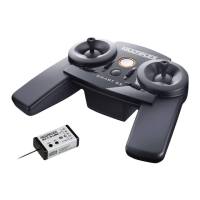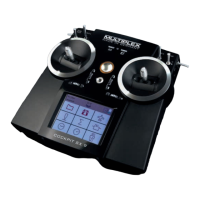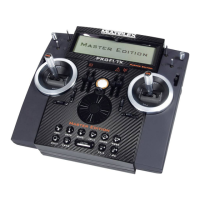Manual
31
11.7. Servo calibration
The advantage of our idea of “global mixers” ( 11.4.) is
that any change which affects multiple servos sharing
the same function only has to be changed as a single
numerical value if you wish to alter a control surface
travel.
To ensure that this procedure works properly, the con-
trol surface travels for servos with the same function
must be set to the same values. Any mechanical dis-
crepancies are corrected in this way.
Example: when a 100% aileron signal is present, the
left aileron deflects by 13.5 mm, the right only 12 mm.
The manufacturer of the model recommends a travel
of 11 mm. You can now calculate the required servo
travel as a percentage value, and set up the model in
the menu ¤Servo.Calibrate.
Typical calculation, for left aileron:
Nominal deflection: 11.0 mm
Actual deflection: 13.5 mm
Formula: (Nom. / Act.) * 100% = (11 / 13.5) * 100%
= 81.48%
You should therefore set: 81%
For the right aileron the setting is as follows:
(11 / 12) * 100% = 91.67% = 92%
Advantage: when the calibration process is complete,
a value of 100% relating to transmitter controls and
mixers means that both ailerons deflect by 11 mm.
The following is also true: 1 mm travel equals a value
of 9%. If, for example, you now wish to raise the ailer-
ons by 2 mm for a particular task, then a mixer input
(Flap control) of 18% is necessary.
11.7.1. What can be calibrated?
Two, three or five points on the servo curve can be
accessed for the calibration process. The number of
points is determined when a new model is set up, but
for each servo this can also be changed subsequently
to any other value in the menu ¤Servo.Assign.
a. 2P (2-point curve)
Only the servo end-points (Points P1 and P5) are
changed. Between these two points the servo
travel is linear.
Application: retracts, tow release, throttle, ...
b. 3P (3-point curve)
In this case the servo centre (Point P3) can be ad-
justed in addition to the two end-points. If you off-
set the centre, the two travels between centre and
end-point remain linear, i.e. the servo curve is now
“bent”.
Application: this equates to the standard form of
servo travel adjustment.
c. 5P (5-point curve)
Adding the two intermediate curve points (Points
P2 and P4) produces a deliberately ”distorted”
servo curve.
Application: this option can be used to generate
non-linear servo travel even for control functions
for which Expo or a curve are not available.
11.7.2. How is the calibration carried out?
There is a separate servo calibration menu which is
accessed as follows:
Main menu (button): K
Menu: Calibrate ....
Sub-menu: 1 AILERON+ ....
Now select the point which you wish to adjust, and
press the 3-D digi-adjuster.
¤Calibr.AILERON+
¨Exit
á
0
P1 -100%
P2 ---
P3 0%
P4 ---
P5 100%
Fig. 11.7.2.1.: Servo calibration with opened % value
The value (e.g. -100%) is now open, and can be al-
tered using the 3-D digi-adjuster.
To alter the travel of one control surface you would
now have to keep the corresponding stick at one end-
point, hold a ruler against the control surface, and op-
erate the 3-D digi-adjuster with your “third hand”.
To simplify this procedure there is the allocation pro-
cess, which is described in the next section.
11.7.3. Allocation - what’s that?
!
Caution
Don’t press the allocation button F until you have set
the servos to the correct direction of rotation.
When a % value is open in the sub-menu ¤Servo.Calibrate,
press the F (allocate) button.
This action sends a control signal to the servo corres-
ponding to the stick position for the point on the servo
curve which you wish to calibrate. The vertical line in
the graph jumps to the opened point, and the cor-
responding servo can now be adjusted.
Example:
Servo 1 operates the left aileron. Point P1 defines the
down-travel. Rotating the 3-D digi-adjuster moves the
servo, and the end-point can be adjusted.
Important!
Pressing the Allocate button sends the control infor-
mation to all the servos which share the same func-
tion. This makes it easy and convenient to set up con-
trol surface travels to match each other accurately.
Examples for fixed-wing model aircraft:
Multi-flap wing
Matching left and right control surfaces to each
other (e.g. with AILERON+ at servos 1 and 5).
Separate elevators with two servos
Matching the travels.
Example for model helicopters:
Electronically mixed swashplate
Setting the swashplate exactly horizontal at the
end-points; if non-linear effects are apparent, the
process can be repeated at the intermediate posi-
tions (P2 and P4).

